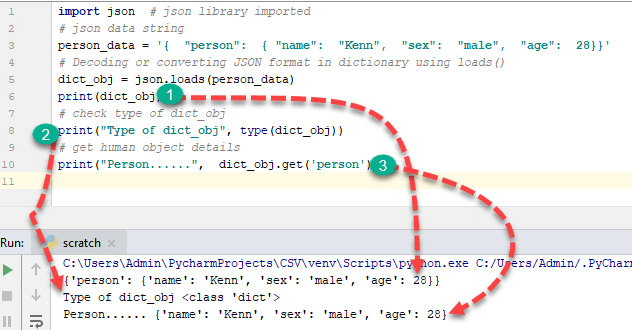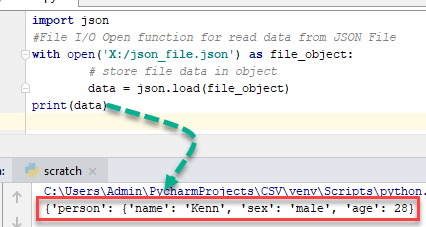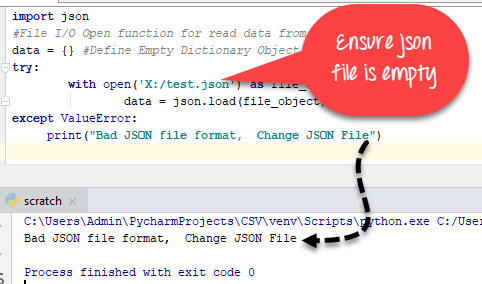Read Json Data From Url in Angularjs
What is JSON in Python?
JSON in Python is a standard format inspired by JavaScript for data commutation and data transfer as text format over a network. Generally, JSON is in string or text format. It can exist used past APIs and databases, and it represents objects as name/value pairs. JSON stands for JavaScript Object Notation.
Python JSON Syntax:
JSON is written as key and value pair.
{ "Key": "Value", "Cardinal": "Value", } JSON is very similar to Python dictionary. Python supports JSON, and it has an inbuilt library as a JSON.
JSON Library in Python
'marshal' and 'pickle' external modules of Python maintain a version of JSON Python library. Working with JSON in Python to perform JSON related operations like encoding and decoding, you demand to beginning import JSON library and for that in your .py file,
import json
Post-obit methods are available in the JSON Python module
| Method | Description |
|---|---|
| dumps() | encoding to JSON objects |
| dump() | encoded cord writing on file |
| loads() | Decode the JSON cord |
| load() | Decode while JSON file read |
Python to JSON (Encoding)
JSON Library of Python performs following translation of Python objects into JSON objects past default
| Python | JSON |
|---|---|
| dict | Object |
| listing | Assortment |
| unicode | String |
| number – int, long | number – int |
| bladder | number – real |
| Truthful | True |
| False | Faux |
| None | Null |
Converting Python data to JSON is called an Encoding functioning. Encoding is washed with the assist of JSON library method – dumps()
JSON dumps() in Python
json.dumps() in Python is a method that converts dictionary objects of Python into JSON cord data format. It is useful when the objects are required to exist in string format for the operations like parsing, printing, etc.
Now lets perform our first json.dumps encoding example with Python:
import json x = { "name": "Ken", "historic period": 45, "married": True, "children": ("Alice","Bob"), "pets": ['Dog'], "cars": [ {"model": "Audi A1", "mpg": 15.i}, {"model": "Zeep Compass", "mpg": eighteen.ane} ] } # sorting result in asscending order past keys: sorted_string = json.dumps(x, indent=4, sort_keys=Truthful) print(sorted_string) Output:
{"person": {"name": "Kenn", "sexual activity": "male", "age": 28}}) Allow'southward see an example of Python write JSON to file for creating a JSON file of the dictionary using the aforementioned function dump()
# hither nosotros create new data_file.json file with write mode using file i/o operation with open up('json_file.json', "due west") as file_write: # write json information into file json.dump(person_data, file_write) Output:
Nothing to show…In your system json_file.json is created. You lot can check that file equally shown in the below write JSON to file Python example.

JSON to Python (Decoding)
JSON string decoding is washed with the help of inbuilt method json.loads() & json.load() of JSON library in Python. Here translation table evidence example of JSON objects to Python objects which are helpful to perform decoding in Python of JSON cord.
| JSON | Python |
|---|---|
| Object | dict |
| Array | list |
| String | unicode |
| number – int | number – int, long |
| number – existent | float |
| Truthful | True |
| False | Imitation |
| Null | None |
Let'due south encounter a basic parse JSON Python instance of decoding with the assist of json.loads function,
import json # json library imported # json data string person_data = '{ "person": { "name": "Kenn", "sexual practice": "male", "age": 28}}' # Decoding or converting JSON format in lexicon using loads() dict_obj = json.loads(person_data) print(dict_obj) # check type of dict_obj print("Blazon of dict_obj", blazon(dict_obj)) # become human being object details impress("Person......", dict_obj.get('person')) Output:
{'person': {'proper noun': 'Kenn', 'sex': 'male person', 'age': 28}} Blazon of dict_obj <class 'dict'> Person...... {'name': 'John', 'sex': 'male person'} 
Decoding JSON File or Parsing JSON file in Python
Now, we will learn how to read JSON file in Python with Python parse JSON instance:
Annotation: Decoding JSON file is File Input /Output (I/O) related operation. The JSON file must be on your organization at specified the location that you mention in your program.
Python read JSON file Example:
import json #File I/O Open function for read data from JSON File with open('X:/json_file.json') equally file_object: # store file data in object data = json.load(file_object) print(data) Here data is a dictionary object of Python as shown in the higher up read JSON file Python case.
Output:
{'person': {'name': 'Kenn', 'sexual activity': 'male person', 'historic period': 28}} 
Compact Encoding in Python
When yous need to reduce the size of your JSON file, you can utilise meaty encoding in Python.
Example,
import json # Create a Listing that contains dictionary lst = ['a', 'b', 'c',{'iv': 5, 'six': 7}] # separator used for compact representation of JSON. # Apply of ',' to identify listing items # Use of ':' to identify key and value in lexicon compact_obj = json.dumps(lst, separators=(',', ':')) impress(compact_obj) Output:
'["a", "b", "c", {"4": v, "6": 7}]' ** Hither output of JSON is represented in a single line which is the most compact representation past removing the space character from compact_obj ** Format JSON code (Pretty print)
- The aim is to write well-formatted code for man agreement. With the help of pretty press, anyone tin can easily understand the code.
Example:
import json dic = { 'a': 4, 'b': 5 } ''' To format the code use of indent and 4 shows number of space and use of separator is not necessary but standard way to write lawmaking of particular office. ''' formatted_obj = json.dumps(dic, indent=4, separators=(',', ': ')) impress(formatted_obj) Output:
{ "a" : iv, "b" : 5 } 
To better sympathise this, alter indent to 40 and observe the output-

Ordering the JSON code:
sort_keys aspect in Python dumps function's argument volition sort the key in JSON in ascending order. The sort_keys argument is a Boolean aspect. When it'southward truthful sorting is immune otherwise not. Let'southward understand with Python string to JSON sorting example.
Case,
import json x = { "name": "Ken", "age": 45, "married": True, "children": ("Alice", "Bob"), "pets": [ 'Domestic dog' ], "cars": [ {"model": "Audi A1", "mpg": fifteen.1}, {"model": "Zeep Compass", "mpg": 18.1} ], } # sorting result in asscending order by keys: sorted_string = json.dumps(ten, indent=4, sort_keys=True) print(sorted_string) Output:
{ "historic period": 45, "cars": [ { "model": "Audi A1", "mpg": fifteen.1 }, { "model": "Zeep Compass", "mpg": 18.1 } ], "children": [ "Alice", "Bob" ], "married": true, "name": "Ken", "pets": [ "Dog" ] } Every bit you may find the keys age, cars, children, etc are arranged in ascending order.
Complex Object encoding of Python
A Circuitous object has two different parts that is
- Real function
- Imaginary part

Example: iii +2i
Before performing encoding of a complex object, you need to bank check a variable is complex or not. Y'all need to create a function which checks the value stored in a variable by using an instance method.
Let'south create the specific function for check object is complex or eligible for encoding.
import json # create part to check instance is complex or non def complex_encode(object): # bank check using isinstance method if isinstance(object, circuitous): return [object.real, object.imag] # raised error using exception handling if object is not complex enhance TypeError(repr(object) + " is not JSON serialized") # perform json encoding past passing parameter complex_obj = json.dumps(4 + 5j, default=complex_encode) impress(complex_obj)
Output:
'[iv.0, five.0]'
Complex JSON object decoding in Python
To decode complex object in JSON, utilize an object_hook parameter which checks JSON cord contains the complex object or not. Lets understand with cord to JSON Python Case,
import json # part check JSON cord contains complex object def is_complex(objct): if '__complex__' in objct: return complex(objct['real'], objct['img']) render objct # use of json loads method with object_hook for check object complex or not complex_object =json.loads('{"__complex__": true, "real": 4, "img": 5}', object_hook = is_complex) #here we not passed complex object then it'southward convert into dictionary simple_object =json.loads('{"real": half-dozen, "img": vii}', object_hook = is_complex) print("Complex_object......",complex_object) print("Without_complex_object......",simple_object) Output:
Complex_object...... (4+5j) Without_complex_object...... {'real': vi, 'img': 7} Overview of JSON Serialization class JSONEncoder
JSONEncoder class is used for serialization of whatever Python object while performing encoding. It contains three different methods of encoding which are
- default(o) – Implemented in the bracket and return serialize object for o object.
- encode(o) – Same as JSON dumps Python method return JSON string of Python data structure.
- iterencode(o) – Represent string ane by i and encode object o.
With the assistance of encode() method of JSONEncoder course, we can likewise encode any Python object as shown in the below Python JSON encoder instance.
# import JSONEncoder class from json from json.encoder import JSONEncoder colour_dict = { "colour": ["reddish", "yellow", "green" ]} # directly called encode method of JSON JSONEncoder().encode(colour_dict) Output:
'{"colour": ["red", "yellow", "green"]}' Overview of JSON Deserialization class JSONDecoder
JSONDecoder grade is used for deserialization of any Python object while performing decoding. Information technology contains three unlike methods of decoding which are
- default(o) – Implemented in the subclass and return deserialized object o object.
- decode(o) – Same as json.loads() method return Python data construction of JSON string or information.
- raw_decode(o) – Correspond Python dictionary one by ane and decode object o.
With the help of decode() method of JSONDecoder class, nosotros tin besides decode JSON string as shown in beneath Python JSON decoder example.
import json # import JSONDecoder class from json from json.decoder import JSONDecoder colour_string = '{ "colour": ["cerise", "yellow"]}' # directly called decode method of JSON JSONDecoder().decode(colour_string) Output:
{'colour': ['blood-red', 'yellow']} Decoding JSON data from URL: Real Life Case
We will fetch data of CityBike NYC (Bike Sharing Organisation) from specified URL(https://feeds.citibikenyc.com/stations/stations.json) and convert into dictionary format.
Python load JSON from file Instance:
NOTE:- Make sure requests library is already installed in your Python, If not then open Final or CMD and blazon
- (For Python iii or above) pip3 install requests
import json import requests # get JSON string information from CityBike NYC using web requests library json_response= requests.become("https://feeds.citibikenyc.com/stations/stations.json") # check blazon of json_response object print(type(json_response.text)) # load data in loads() role of json library bike_dict = json.loads(json_response.text) #check type of news_dict print(type(bike_dict)) # now get stationBeanList key data from dict print(bike_dict['stationBeanList'][0]) Output:
<course 'str'> <form 'dict'> { 'id': 487, 'stationName': 'Eastward twenty St & FDR Bulldoze', 'availableDocks': 24, 'totalDocks': 34, 'latitude': 40.73314259, 'longitude': -73.97573881, 'statusValue': 'In Service', 'statusKey': 1, 'availableBikes': 9, 'stAddress1': 'E 20 St & FDR Bulldoze', 'stAddress2': '', 'city': '', 'postalCode': '', 'location': '', 'altitude': '', 'testStation': False, 'lastCommunicationTime': '2018-12-eleven x:59:09 PM', 'landMark': '' } Exceptions Related to JSON Library in Python:
- Class json.JSONDecoderError handles the exception related to decoding functioning. and it's a subclass of ValueError.
- Exception – json.JSONDecoderError(msg, doc)
- Parameters of Exception are,
- msg – Unformatted Error message
- medico – JSON docs parsed
- pos – start alphabetize of doc when it's failed
- lineno – line no shows correspond to pos
- colon – column no correspond to pos
Python load JSON from file Example:
import json #File I/O Open function for read data from JSON File data = {} #Define Empty Dictionary Object try: with open up('json_file_name.json') as file_object: information = json.load(file_object) except ValueError: impress("Bad JSON file format, Change JSON File") 
Infinite and NaN Numbers in Python
JSON Data Interchange Format (RFC – Request For Comments) doesn't allow Infinite or Nan Value simply there is no restriction in Python- JSON Library to perform Infinite and Nan Value related operation. If JSON gets Infinite and Nan datatype than it's converted information technology into literal.
Example,
import json # pass float Infinite value infinite_json = json.dumps(float('inf')) # bank check infinite json blazon print(infinite_json) print(type(infinite_json)) json_nan = json.dumps(bladder('nan')) print(json_nan) # pass json_string equally Infinity infinite = json.loads('Infinity') print(space) # check type of Infinity print(type(infinite)) Output:
Infinity <class 'str'> NaN inf <class 'float'>
Repeated primal in JSON String
RFC specifies the key name should exist unique in a JSON object, simply information technology'due south not mandatory. Python JSON library does non heighten an exception of repeated objects in JSON. It ignores all repeated cardinal-value pair and considers only final central-value pair amid them.
- Example,
import json repeat_pair = '{"a": one, "a": 2, "a": iii}' json.loads(repeat_pair) Output:
{'a': 3} CLI (Control Line Interface) with JSON in Python
json.tool provides the command line interface to validate JSON pretty-print syntax. Allow's run into an instance of CLI

$ echo '{"name" : "Kings Authur" }' | python3 -m json.tool Output:
{ "name": " Kings Authur " } Advantages of JSON in Python
- Piece of cake to motility back between container and value (JSON to Python and Python to JSON)
- Human readable (Pretty-print) JSON Object
- Widely used in data handling.
- Doesn't have the same data structure in the single file.
Implementation Limitations of JSON in Python
- In deserializer of JSON range and prediction of a number
- The Maximum length of JSON cord and arrays of JSON and nesting levels of object.
Python JSON Cheat Sheet
| Python JSON Function | Description |
|---|---|
| json.dumps(person_data) | Create JSON Object |
| json.dump(person_data, file_write) | Create JSON File using File I/O of Python |
| compact_obj = json.dumps(data, separators=(',',':')) | Compact JSON Object by removing infinite character from JSON Object using separator |
| formatted_obj = json.dumps(dic, indent=four, separators=(',', ': ')) | Formatting JSON code using Indent |
| sorted_string = json.dumps(10, indent=four, sort_keys=True) | Sorting JSON object key by alphabetic lodge |
| complex_obj = json.dumps(4 + 5j, default=complex_encode) | Python Complex Object encoding in JSON |
| JSONEncoder().encode(colour_dict) | Use of JSONEncoder Form for Serialization |
| json.loads(data_string) | Decoding JSON String in Python dictionary using json.loads() function |
| json.loads('{"__complex__": truthful, "real": 4, "img": five}', object_hook = is_complex) | Decoding of circuitous JSON object to Python |
| JSONDecoder().decode(colour_string) | Apply of Decoding JSON to Python with Deserialization |
Source: https://www.guru99.com/python-json.html
0 Response to "Read Json Data From Url in Angularjs"
Post a Comment